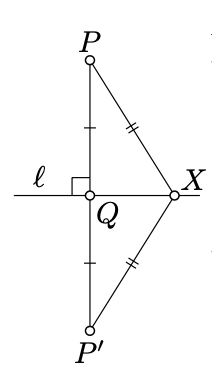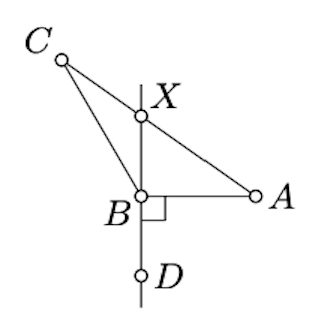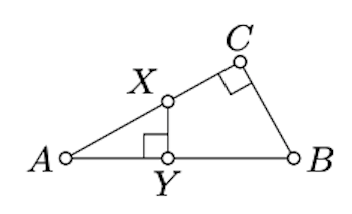5.5: La perpendicular es la más corta
- Page ID
- 114847
Asumir\(Q\) es el punto del pie de\(P\) en la línea\(\ell\). Entonces la desigualdad
\(PX > PQ\)
se mantiene para cualquier punto\(X\) en\(\ell\) distinto de\(Q\).
Si\(P, Q\), y\(\ell\) son como arriba, entonces\(PQ\) se llama la distancia de\(P\) a\(\ell\).
- Prueba
-
Si\(P \in \ell\), entonces el resultado sigue desde\(PQ = 0\). Además suponemos que\(P \not\in \ell\).

Que\(P'\) sea el reflejo del\(P\) otro lado de la línea\(\ell\). Tenga en cuenta que\(Q\) es el punto medio de\([PP']\) y\(\ell\) es la bisectriz perpendicular de\([PP']\). Por lo tanto
\(PX = P'X\)y\(PQ = P'Q = \dfrac{1}{2} \cdot PP'\)
Tenga en cuenta que\(\ell\) se reúne\([PP']\) sólo en el punto\(Q\). Por lo tanto,\(X \not\in [PP']\); por desigualdad triangular y Corolario 4.4.1,
\(PX + P'X > PP'\)
y de ahí el resultado:\(PX > PQ\).
Supongamos que\(\angle ABC\) es correcto u obtuso. Demostrar que
\(AC > AB.\)
- Pista
-

Si\(\angle ABC\) es correcto, la declaración se desprende de Lemma\(\PageIndex{1}\). Por lo tanto, podemos suponer que\(\angle ABC\) es obtuso.
Dibuja una línea\((BD)\) perpendicular a\((BA)\). Ya que\(\angle ABC\) es obtuso, los ángulos\(DBA\) y\(DBC\) tienen signos opuestos.
Por Corolario 3.4.1,\(A\) y\(C\) se encuentra en lados opuestos de\((BD)\). En particular,\([AC]\) se cruza\((BD)\) en un punto; denotarlo por\(X\).
Tenga en cuenta que\(AX < AC\) y por Lemma\(\PageIndex{1}\),\(AB \le AX\).
Supongamos que\(\triangle ABC\) tiene ángulo recto en\(C\). Demuestre que para cualquier\(X \in [AC]\) la distancia de\(X\) a\((AB)\) es menor que\(AB\).
- Pista
-

Deja\(Y\) ser el punto del pie de\(X\) on\((AB)\). Aplica Lemma\(\PageIndex{1}\) para demostrarlo\(XY < AX \le AC < AB\).


